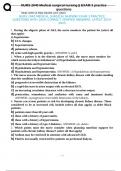Exam (elaborations)
NURS 2040 MEDICAL SURGICAL NURSING EXAM 3 PRACTICE QUESTIONS WITH 100% CORRECT VERIFIED ANSWERS. LATEST
- Course
- Institution
- Book
Trusted by instructors, students, and practicing nurses for more than 50 years, the 14th edition of this landmark resource has been comprehensively updated to reflect the latest research and practices and keep pace with the transition from critical care to home care, ethics, and genetics.
[Show more]



